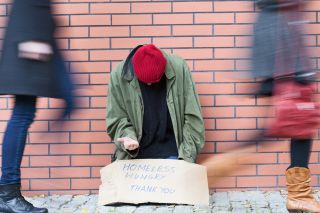Bystander Effect
Is There No Such Thing as a Good Samaritan?
Why people help others, or don't help, is more complicated than you may think.
Posted December 22, 2022 Reviewed by Vanessa Lancaster
Key points
- The origins of the well-known "bystander effect" are not as clear as they've been portrayed.
- We can partly attribute helping behavior or the lack thereof to neurological differences.
- Other significant influences on helping behavior can come from the components of personality.
Happy holidays! At this time of year, we’re often reminded to be generous–to give to the neediest and to think of others who are less well-off than we are. But does this annual spike in generosity really happen the way it should?
Students of psychology or New York City history might remember the example of Kitty Genovese–the young woman murdered in Queens in 1964, who reportedly screamed out to more than three dozen people as she was being assaulted, then died without receiving any help. The case shocked American sensibilities and led to the recognition of the “bystander effect,” which means the presence of bystanders at an accident tends to make each of them slower and less likely to report the problem.

Later reporting on Kitty Genovese’s death revealed significant inconsistencies in the original story. In 2016, the New York Times criticized its 1964 article as having “grossly exaggerated the number of witnesses and what they had perceived.”
And even as the real facts of this case have been revised, the bystander effect has recently come under a critical eye. Perhaps the inhibiting effect of bystanders on helping behavior is not as simple as it seems. Maybe personality has something to do with it, or maybe, some people are more likely to help than others.
The original concept of bystander apathy was premised on three component factors: diffusion of responsibility (a reduction in individual responsibility due to the size of a crowd), evaluation apprehension (the concern about being judged by others for taking action), and pluralistic ignorance (the tendency to underestimate an emergency, simply because no one else is doing anything to help).
As noted earlier, each of these factors is characterized by the presence of others, suggesting that the crowd creates the bystander effect. Recent studies have investigated the neurological origins of helping behavior, and their conclusions throw some doubt on the purely psychosocial basis of the bystander effect. One particular area of the human brain (the medial prefrontal cortex, to be exact) has been linked to prosocial behavior, like regularly taking time out of one’s own schedule to help others (Rameson, Morelli, & Lieberman, 2012). Other evidence indicates that the decision not to help someone in danger might be an automatic response, or something like a reflex (Rand, 2016; Zaki & Mitchell, 2013).
How might this work? In 2018, Dutch psychologists Ruud Hortensius and Beatrice de Gelder collaborated to reconcile the social origins of bystander apathy with the individual neurological contributions of personality. Hortensius and de Gelder identified two independent but connected processes. They stated that a witness’s distress system takes over immediately after an emergency is detected. Can the witness regulate this anxiety well enough to take action? Or are they inhibited, frozen in place?
After a few minutes, however, another system takes over: sympathy. Understanding what it might be like to be the one in distress–to assume their perspective, and to try to feel their pain–allows a connection to develop. This sense of sympathy can help bystanders regulate their distress and think more clearly–to decide whether or not to help. As Hortensius and de Gelder (2018) put it, the first process is “reflexive,” while the second is “reflective”–first emotional, then cognitive. Together, these internal processes result in a bystander’s conclusion about whether or not to help.
And what of the three original social factors: diffusion of responsibility, evaluation apprehension, and pluralistic ignorance? These contributions to a witness’s course of action may reflect a summing up of the reflexive and reflective factors listed by Hortensius and de Gelder. In other words, the effects of a crowd on an individual’s decision to help–its tendency to diffuse responsibility, create fears of judgment, and confuse the level of emergency–may be better explained as umbrella terms, encapsulating the cognitive and instinctual internal processes described above.
A bystander’s level of personal distress, processed through “emotional regulation, behavioral inhibition, and perspective taking,” may result in an external decision premised on factors very much like the ones Darley and Latané described initially. The bystanders who do not help, then–according to Hortensius and de Gelder–are behaving reflexively as a result of internal neurological processes. Their ability to regulate the emotions that arise from their immediate responses, and to take on the perspective of the person who may need their help, may not allow them to make a more prosocial choice.
All of which goes to say, at this time of year, that the decision to help others–or not to help, as the case may be–isn’t as simple as the sad history of Kitty Genovese may once have made it sound.
We all have a choice whether or not to help someone in need during the holiday season or any other time. Despite our instincts or reflexes, with the ability to regulate our emotions well, inhibit impulsive behavior, and absorb the perspectives of others in need, each of us has a better chance of deciding to help when the time is right.
References
Darley, J. M., & Latane, B. (1968). Bystander intervention in emergencies: Diffusion of responsibility. Journal of Personality and Social Psychology, 8(4, Pt.1), 377–383. Retrieved from https://doi.org/10.1037/h0025589
Haberman, C. (2016, April 10). Remembering Kitty Genovese. The New York Times. Retrieved from https://www.nytimes.com/2016/04/11/us/remembering-kitty-genovese.html
Hortensius & de Gelder (2018). From empathy to apathy: The bystander effect revisited. Current Directions in Psychological Science, 27(4), 249–256. Retrieved from https://www.ncbi.nlm.nih.gov/pmc/articles/PMC6099971/
Morelli SA, Rameson LT, Lieberman MD. (2014). The neural components of empathy: predicting daily prosocial behavior. Soc Cogn Affect Neurosci.;9(1):39-47. Retrieved from https://pubmed.ncbi.nlm.nih.gov/22887480/
Rand, D. G. (2016). Cooperation, fast and slow: Meta-analytic evidence for a theory of social heuristics and self-interested deliberation. Psychological Science, 27(9), 1192–1206. Retrieved from https://doi.org/10.1177/0956797616654455
Zaki, J., & Mitchell, J. P. (2013). Intuitive Prosociality. Current Directions in Psychological Science, 22(6), 466–470. Retrieved from https://doi.org/10.1177/0963721413492764


